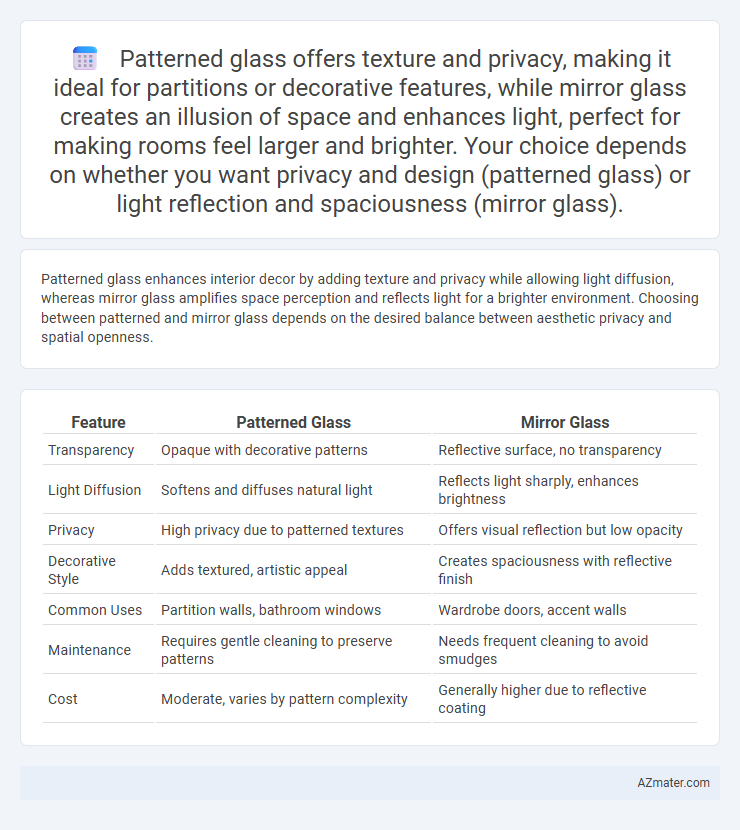Patterned glass enhances interior decor by adding texture and privacy while allowing light diffusion, whereas mirror glass amplifies space perception and reflects light for a brighter environment. Choosing between patterned and mirror glass depends on the desired balance between aesthetic privacy and spatial openness.
Table of Comparison
| Feature | Patterned Glass | Mirror Glass |
|---|---|---|
| Transparency | Opaque with decorative patterns | Reflective surface, no transparency |
| Light Diffusion | Softens and diffuses natural light | Reflects light sharply, enhances brightness |
| Privacy | High privacy due to patterned textures | Offers visual reflection but low opacity |
| Decorative Style | Adds textured, artistic appeal | Creates spaciousness with reflective finish |
| Common Uses | Partition walls, bathroom windows | Wardrobe doors, accent walls |
| Maintenance | Requires gentle cleaning to preserve patterns | Needs frequent cleaning to avoid smudges |
| Cost | Moderate, varies by pattern complexity | Generally higher due to reflective coating |
Introduction to Patterned and Mirror Glass
Patterned glass features textured surfaces that diffuse light and provide privacy while enhancing aesthetic appeal in interior decor. Mirror glass offers a reflective surface that visually expands spaces and adds brightness by reflecting natural and artificial light. Both materials serve distinct functional and decorative purposes, enabling versatile design solutions in residential and commercial interiors.
Key Differences Between Patterned Glass and Mirror Glass
Patterned glass features textured or embossed designs that diffuse light and provide privacy while adding decorative appeal, making it ideal for partitions and cabinet doors. Mirror glass reflects images with high clarity and brightness, enhancing room depth and light but offering no privacy. The key differences lie in functionality: patterned glass balances aesthetics and obscuration, whereas mirror glass emphasizes reflection and illumination.
Aesthetic Appeal: Enhancing Interior Spaces
Patterned glass introduces texture and visual interest by diffusing light and creating dynamic reflections that enhance aesthetic appeal in interior decor. Mirror glass provides a sleek, reflective surface that amplifies natural light and visually expands space, promoting a modern and polished look. Combining patterned and mirror glass elements can elevate interior spaces by balancing texture with reflection for unique design effects.
Light Diffusion and Privacy Features
Patterned glass offers superior light diffusion by scattering natural and artificial light, creating a soft, ambient glow while maintaining privacy through its textured surface. Mirror glass reflects light sharply, enhancing brightness and making spaces appear larger but compromises privacy due to its clear reflective properties. For interior decor, patterned glass is ideal in areas where privacy and gentle light distribution are priorities, whereas mirror glass suits spaces demanding increased illumination and visual expansion without privacy needs.
Practical Applications in Home Décor
Patterned glass enhances privacy and diffuses light, making it ideal for bathroom windows, shower enclosures, and decorative room dividers. Mirror glass amplifies natural light and creates the illusion of spaciousness, often used in living rooms, bedrooms, and hallways to visually expand interiors. Both materials balance aesthetics with functionality, offering unique textural and reflective qualities to complement various home decor styles.
Durability and Maintenance Considerations
Patterned glass offers enhanced durability with its textured surface that effectively conceals minor scratches and smudges, reducing the need for frequent cleaning. Mirror glass, while sleek and reflective, requires regular maintenance to prevent visible streaks, fingerprints, and tarnishing over time. Choosing patterned glass for interior decor often results in lower upkeep costs and longer-lasting aesthetic appeal compared to mirror glass.
Cost Comparison: Patterned vs Mirror Glass
Patterned glass generally costs less than mirror glass due to simpler manufacturing processes and lower material usage. Mirror glass requires additional reflective coatings and precision finishing, increasing its overall price. When budgeting for interior decor, choosing patterned glass can offer cost-effective style without compromising aesthetic appeal compared to the higher investment needed for mirror glass.
Sustainability and Environmental Impact
Patterned glass offers a more sustainable choice in interior decor due to its ability to optimize natural light diffusion, reducing the need for artificial lighting and lowering energy consumption. Mirror glass, while aesthetically appealing, often requires higher energy inputs for production and involves more intensive finishing processes, increasing its environmental footprint. Selecting patterned glass supports eco-friendly design by enhancing energy efficiency and utilizing less resource-intensive manufacturing techniques.
Current Trends in Glass Interior Design
Patterned glass offers textured surfaces that enhance privacy while allowing natural light, making it popular in modern interior design for creating visually dynamic spaces. Mirror glass continues to dominate for its ability to visually expand rooms and add brightness, frequently used in contemporary homes and commercial settings. Current trends emphasize combining both materials to balance functionality and aesthetic appeal, integrating patterned glass panels alongside sleek mirror installations for sophisticated, layered interiors.
Choosing the Right Glass for Your Space
Patterned glass enhances privacy and diffuses light, making it ideal for spaces requiring subtle separation without sacrificing brightness, such as bathrooms or office partitions. Mirror glass reflects light and expands visual space, perfect for smaller rooms or areas needing a decorative focal point like living rooms or hallways. Selecting the right glass depends on balancing aesthetics, function, and the room's lighting conditions to achieve the desired atmosphere and utility.

Infographic: Patterned glass vs Mirror glass for Interior décor
 azmater.com
azmater.com